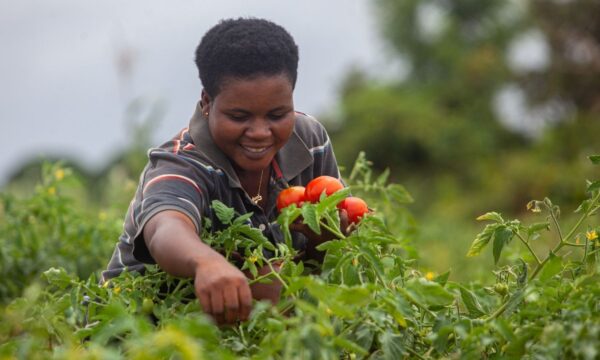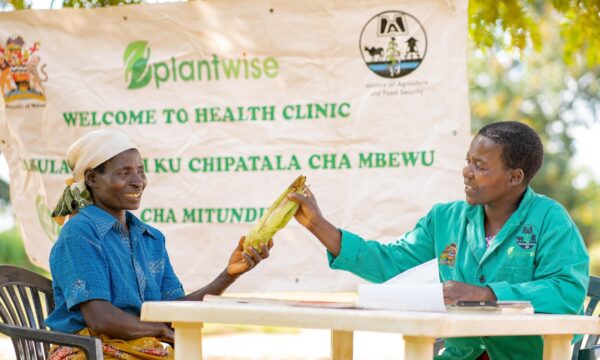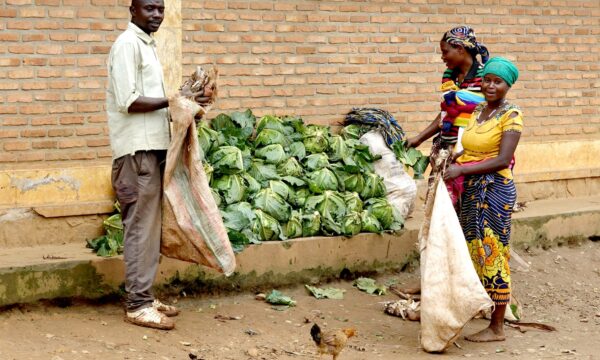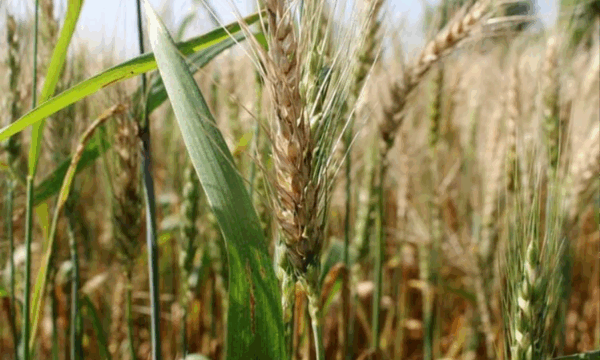Mango mealybugs are one of the most important insect pests affecting mango production across tropical and subtropical regions in Africa and Asia. These sap-sucking insects not only reduce the quantity and quality of fruit but can also weaken trees over time, leading to long-term production losses. Several species fall under the broad category of “mango mealybugs,” each with variations in characteristics and distribution, which we will explore in this blog.
Species of mango mealybugs
Several mealybug species are known to attack mango trees, particularly Drosicha mangiferae, Drosicha stebbingi, Rastrococcus iceryoides, and Rastrococcus invadens.
D. mangiferae and D. stebbingi, also commonly known as the giant mealybug, are found in India, Pakistan, Bangladesh, and China. Due to their similarities in appearance and behaviour, these two species are often treated as synonyms. Alternative host species include papaya, cotton, guava, tomatoes and others.
R. iceryoides, also sometimes referred to as the downey snow line mealybug, is present in the East African countries of Kenya, Malawi, and Tanzania, as well as in parts of South and Southeast Asia, including India, Bangladesh, Indonesia and Malaysia. This species is quite polyphagous, meaning it can feed on many types of plants, but its main hosts, in addition to mango, are Indian siris, citrus, lime, coffee, cotton, and cocoa.
R. invadens, or the fruit tree mealybug, is more widespread than the other species. It’s found throughout Central and Western Africa, including in Ghana, Nigeria, and Uganda, as well as in numerous Asian countries such as India, Thailand, Vietnam, and China. In addition to mango, this pest also affects breadfruit, banana, citrus, fig, and frangipani.
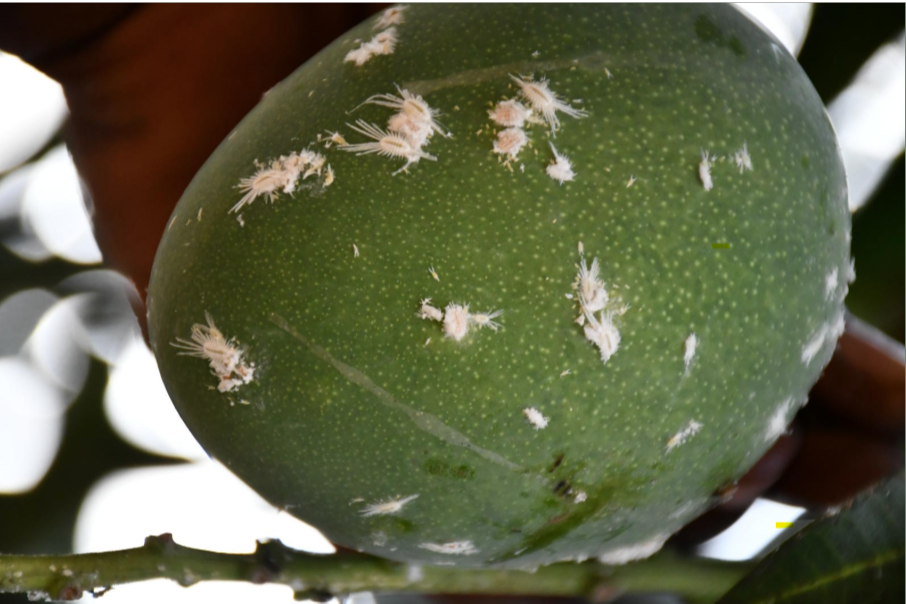
Identification of mango mealybugs
Adult mealybugs are usually oval-shaped, soft-bodied, and coated in a white powdery wax. The adult males are around 1.5-2mm long and are winged but rarely seen. Whilst the adult females are larger (2-5mm long) and wingless. Eggs hatch into nymphs, also known as “crawlers,” which are mobile and represent the most vulnerable life stage for control.
D. mangiferae mealybugs are initially brown in colour. Adult females are wingless, about half the size of a fingernail, and are covered with white wax that gives them a powdery appearance. They lay eggs in small, white, waxy sacs. Male adults, on the other hand, are brick red, with brown-black wings, and are smaller than the females. R. iceryoides adults are oval and pale yellow with a prominent white waxy coating, while R. invadens adult females are pale greenish-white and covered with wax, except for a narrow strip along the midline.
Symptoms and damage
Mealybugs affect their host plants in a couple of key ways. They can damage mango trees by sucking sap from young twigs, buds, leaves, flowers, and fruits. Although R. invadens is not known to cause primary feeding damage to its tree host plants. Mealybugs tend to live in clusters on these plant parts. As they feed, they excrete a sugary substance known as honeydew, which encourages the growth of sooty mould fungus. This black fungus causes the biggest problems; it interferes with the plant’s photosynthesis, reducing its energy production.
Severely infested leaves often turn yellow, dry out, and fall off prematurely. In addition to leaf loss, affected trees can suffer from slow growth, reduced flowering and fruit set, and young fruits may drop off before maturing. Infestations are often accompanied by ants, which are attracted to the honeydew and protect the mealybugs from natural predators.
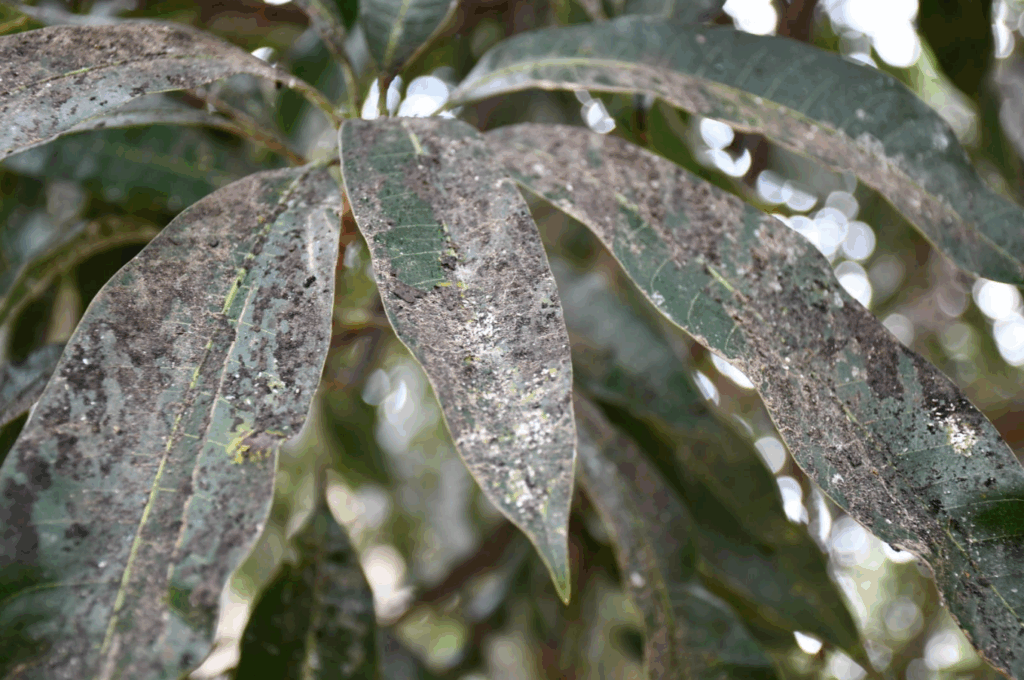
Mealybug lifecycle
The lifecycle of mango mealybugs typically begins with the females laying eggs in a cottony sac, either in the soil or attached to plant parts (crown, leaves, bark, etc.). The eggs remain dormant for several months before hatching. The newly hatched nymphs (crawlers) move up the plant towards the leaves to feed by crawling up the trunk or via low-hanging or touching branches. However, the older nymphs are not as fast-moving as the younger nymphs. Mealybugs go through several instars before becoming mature adults.
Outdoors, mango mealybugs tend to cause damage through the warmer spring and summer months. Wind, rain, birds, ants, and even human activities, such as transporting infected seedlings, facilitate the movement and spread of mealybugs.
Management strategies
Prevention
Effective management begins with prevention. It is crucial to source clean, pest-free planting material for new orchards. Thoroughly clean tools and clothing before moving between fields to avoid accidental transfer. Collect and destroy fallen leaves and plant debris by burning.
Deep ploughing in winter, especially between tree rows, and regular hoeing of the soil under tree canopies can expose eggs laid in the soil to sunlight and predators. Introducing flowering strips, such as African marigold, Coreopsis (tickseed) or fennel, within the farm can help attract and sustain natural enemies of mealybugs. The removal of alternate host plants (like guava and citrus) from field borders, and weeds (particularly in Spring around the base of the trees), further reduces pest populations. Finally, pruning low-hanging branches and infected twigs helps to limit the pest’s movement and spread.
Monitoring
Regular monitoring is essential to detect infestations early. Carry out inspections once a month during the seedling, vegetative, and fruiting stages. Increase inspections to every 2-3 days in winter, if possible, when eggs are laid. Each inspection should involve checking 100 leaves from five different trees per acre. It is also useful to check the tree trunk, stem joints, twigs and inflorescence. Look for the presence of mealybug colonies, groups of white powdery-covered insects, sticky honeydew (a colourless honey-like substance), a black powdery substance on the leaves and branches, and the presence of attendant ants. Monitor previously attacked plants more regularly.
Consider some action as soon as you find mango mealybugs, as they are likely to have already laid eggs. Take action when two or more of every ten leaves are infested with mealybugs, especially if young trees or fruit-bearing twigs are affected.
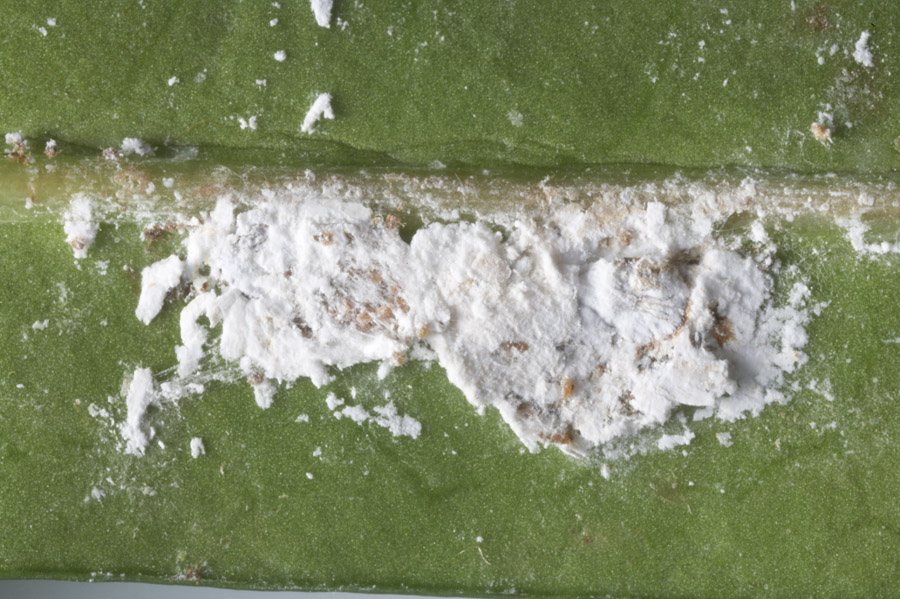
Direct Control
When mealybugs are identified, implement direct control measures without delay. Physical barriers such as plastic sheets and sticky grease bands around the tree trunks—about 1m above the ground—can prevent nymphs from crawling up. These bands also stop ants from climbing the tree, which aids natural predators. Controlling ant populations by applying ash on ant colonies can also help reduce the protection mealybugs receive from them.
Manual control methods include sweeping or collecting nymphs from the trunk and crushing visible colonies. In cases of severe infestation, heavily affected branches should be pruned and burned. The mealybugs can also be blasted off with a strong stream of water during the early stages of infestation.
Biological control options include releasing predatory beetles like Cryptolaemus montrouzieri and parasitoid wasps such as Anagyrus pseudococci, A. mangicola or Gyranusoidea tebygi. Organic neem-based sprays or oils, or insecticidal soap sprays (like Alata, liquid dish soap or baby shampoo), can disrupt the insect’s waxy coating, making them vulnerable to adverse conditions. Fungal biopesticides, such as Beauveria bassiana or Lecanicillium lecanii, applied to the trunk can also be effective on nymphs. Consult your local extension worker or agro-input dealer for registered products in your area.
When using a pesticide or botanical, always wear protective clothing and follow the instructions on the product label, such as dosage, timing of application, pre-harvest interval, maximum number of sprays, and restricted re-entry interval. Do not empty into drains and water sources. Sprays are harmful to predatory mites and parasitoids so will reduce natural enemy populations.
Chemical control
Chemical control can be considered for mango mealybug infestations; in such cases, targeted spraying with insecticides may be necessary.
Take precautions to avoid causing harm to pollinators and other beneficial insects. Apply pesticides early in the morning or late in the evening. It is important to observe the pre-harvest interval and adhere to all safety guidelines.
Recommendations are likely to be different for nymphs and adults, as well as for different locations. For further information and local recommendations, visit your local extension worker or agro-dealer.
Conclusion
Mango mealybugs pose a serious threat to mango production across Asia and Africa. Effective control requires a combination of preventive practices, regular monitoring, biological control, and, when necessary, chemical intervention. By taking an integrated pest management approach, farmers can protect their mango trees, preserve yields, and maintain the long-term health of their orchards.
Additional resources on mango mealybugs
Global resources:
Rastrococcus iceryoides (mango mealy bug) (Technical Factsheet)
Rastrococcus invadens (fruit tree mealybug) (Technical Factsheet)
Country-specific guidance:
Bangladesh – Giant mealybug: Drosicha mangiferae (PMDG)
Ghana – Mealybug in mango: Rastrococcus iceryoides (Rastrococcus invadens) (PMDG)
India – Mango mealy bug: Drosicha Mangiferae (PMDG)
Kenya – Mealybugs on mangoes: Drosicha mangiferae (PMDG)
Pakistan – Mango Mealy Bug: Drosicha mangiferae – Pakistan (PMDG) / Urdu version or Mango Mealybug: Drosicha mangiferae – Pakistan (PFFF) / Urdu version
Rwanda – Mango mealybug in mango: Drosicha mangiferae (PMDG) or Mealybug on mango: Rastrococcus invadens – Rwanda (PMDG)
Related News & Blogs
Most read blogs of 2025
As 2025 comes to a close, we’ve tallied the numbers to reveal the top 10 most read blogs on the PlantwisePlus Blog this year, plus a few firm favourites! Our most read blogs feature voices from those benefiting from our work, as well as crop pest guide…
17 December 2025

